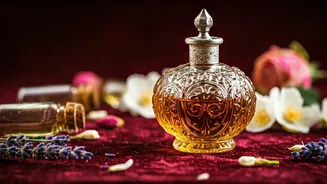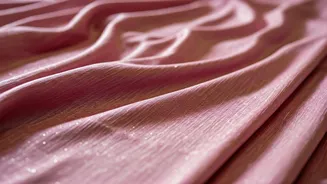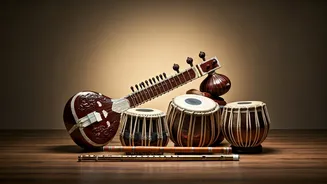The Scented Dawn
The use of fragrance dates back millennia, tracing its roots to ancient civilizations who embraced aromatic substances for spiritual and ritualistic practices.
Egyptians, for example, incorporated fragrant oils and resins in religious ceremonies, believing these scents possessed divine properties. Incense, a key element in ancient religious practices, was burned to honor the gods and was believed to carry prayers to the heavens. Across the globe, various cultures, including the Greeks and Romans, integrated perfumes into their daily routines, using them for medicinal purposes and as a symbol of status. Fragrance's evolution demonstrates a fascinating blend of religious beliefs, practical applications, and societal ideals, transforming it from a sacred offering to a luxurious commodity. The demand for fragrant ingredients fueled global trade routes, facilitating the exchange of exotic scents and techniques that spread across continents, shaping the development of perfumery as an art form.
Evolution of Perfume
The journey of perfumery has been an evolution, influenced by technological advancements and shifting cultural preferences. The Middle Ages saw the emergence of alcohol-based perfumes, offering a new way to preserve and wear fragrances. This innovation, coupled with the flourishing spice trade, led to an increase in fragrant ingredients and a boom in perfumery across Europe. The Renaissance era witnessed the rise of elaborate perfumed products, popular among the wealthy elite. Perfume's journey has been marked by scientific discoveries, such as the development of distillation and solvent extraction methods, enabling the isolation and use of a wider variety of fragrant materials. The 19th and 20th centuries were critical for the industry, with the introduction of synthetic ingredients that allowed perfumers to create complex and innovative fragrance compositions. These changes paved the way for the modern perfume industry, allowing for mass production and making fragrances accessible to a broader audience.
Fragrance Families Explored
Fragrances are categorized into different families, with each family showcasing distinct characteristics and olfactory profiles. Floral fragrances, as the name suggests, feature the dominant notes of flowers like rose, jasmine, and lily of the valley, conveying elegance and femininity. Citrus fragrances use zesty and refreshing notes derived from citrus fruits such as lemon, bergamot, and grapefruit, imparting a sense of energy and vitality. Woody fragrances often offer warm and grounding aromas drawn from trees, sandalwood, cedarwood, and vetiver are common examples. Oriental fragrances, generally rich and exotic, incorporate spices, resins, and vanilla, creating a sense of luxury and mystery. Understanding these fragrance families helps individuals navigate the world of perfume, allowing them to choose scents that reflect their personal tastes and evoke the desired emotions.
Fragrance and Culture
Across various cultures, fragrance plays a significant role in personal expression, social rituals, and even economic practices. In some cultures, applying perfume is seen as a daily ritual, integral to personal grooming and conveying a sense of identity. Fragrances may be linked to certain occasions or ceremonies, reflecting cultural traditions and values. Beyond personal use, the fragrance industry serves as a source of economic activity, impacting both producers of raw materials and consumers of finished products. The design and promotion of fragrances are often influenced by cultural trends, marketing narratives, and societal values. The choice of a specific fragrance can reflect one's personality, aspirations, or cultural background. Therefore, the connection between fragrance and culture is undeniable, demonstrating its widespread impact on individuals and communities.
Fragrance Today
In the modern world, fragrance continues to captivate, evolving with trends and technologies. Contemporary perfumery explores sustainability, seeking natural and ethically sourced ingredients. The development of innovative fragrance technologies, such as micro-encapsulation, increases the longevity of scents. The internet and social media have revolutionized how people discover and purchase perfumes, offering an expansive range of choices and consumer reviews. The trend toward personalization continues as consumers seek unique, custom-made fragrances that reflect their individuality. Additionally, the fragrance industry has responded to the growing interest in health and wellness by producing fragrances formulated to elicit specific emotional states or therapeutic benefits. Today's fragrance scene is dynamic, responding to consumer desires and broader cultural trends, with a focus on innovation, sustainability, and personal expression, making it more engaging than ever.











